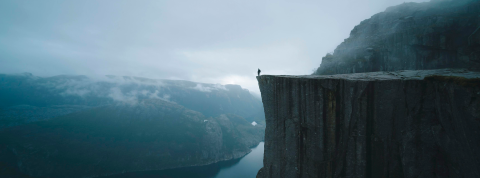
AI and the Future of Human Creativity
Dr Kimble stops dead in his tracks. The escape had come to an end. Officer Gerard points his gun at him and asks him to put down his pistol and give himself up. The fugitive has no way out. Facing him is a police officer who will not stop until he is arrested. Behind him, a free fall of over fifty metres. He knows that all will be lost if he gives himself up; they will convict him of killing his wife without having caught the real culprit. If he jumps.... if he jumps he might have a chance...
Fear of the abyss made the star of the film The Fugitive (Davis, 1993) decide to stop fighting for his innocence and surrender to his fatal destiny, although his conviction was greater than his fear and he decided to jump. Luck, and the demands of the script, was on his side, and the doctor not only survived the fall but was ultimately able to prove his innocence.
In life, we often encounter crossroads that are difficult to distinguish. Without the urgency of the fugitive, yet risking valuable questions, we must decide on the lesser of two evils and guess which of the two confusing roads will be the right one to take. We are currently facing one of these dilemmas. Generative Artificial Intelligence (AI) has exploded, and society is debating between fear and acceptance. Some see in this new technology the threat of losing their job, their privacy or even their humanity, whereas others see in AI an efficient, helpful tool or even a new evolutionary era.
Changes always provoke resistance. The Luddite Movement arose in England in the early 19th century, a movement of textile works who protested against machinery in the Industrial Revolution. Arguing that process automation would drive down product quality and wages while their working hours increased, the Luddites entered factories and took hammers to the machinery to destroy it. Almost two centuries later, the digital era brought mobilisations by the cultural sector, rebelling against the exchange of files among internet users. Those involved demonstrated and pressured legislators to put an end to this piracy.
These protests helped improve the conditions of those affected by technological innovations. Trade unions arose as a result of the Industrial Revolution, and new strategies o share content and monetise under new business models such as streaming platforms or branded content as a result of the digital revolution. In neither case did technology take a step backwards.
We are now witnesses of a new revolution, AI. The fastest-paced of all, without a doubt. The Industrial Revolution started in Great Britain in around 1760 and took over one hundred years to reach the United States. Facebook took ten months to reach its first one million users. ChatGPT was launched in November 2022, reaching the one-million-user mark in barely one week.
It is normal to be afraid of the abyss that is opening up before our very eyes. From almost one day to the next, there are now a multitude of tools capable of automating processes that previously required human involvement and knowledge. The foundations of many professional processes are tottering. What sense does it make for a teacher to ask for the summary of the book as proof of it having been read? Why learn to program when AI programs video games based on simple prompts? Why bother if AI will soon do my job better and faster than I can?
There will always be things to do, even if it means jumping into the abyss
Well, because there will always be things to do. Last May, Robert Altman, CEO of OpenAI, the parent company of ChatGPT, took part in the Global AI Summit organised by the UN in Geneva. It was there that he stated that AI "won’t take all our jobs”, because there will always be “new things to do”. And that is the key to any evolutionary leap, finding which new added value the human being can provide. When we invented agriculture and farming, we gained time to come up with new forms of artistic, technical and technological creation that enabled us to evolve as a society. If I no longer have to waste an hour looking for data to draft a report, I can spend more time analysing results and proposing actions for improvement.
It is true that the analytical capacity of AI is increasing exponentially, although at present this technology is not prepared to walk alone. Currently, use of Generative AI is directly proportional to the prior knowledge of the subject, as AI expert Jorge Guillén points out. Someone who knows nothing about the legal professional cannot leave the defence of a client in the hands of AI, just as a marketing expert is needed to produce an effective brand strategy.
Although it is true that there are certain areas in which AI is evolving so rapidly that it is able to replace human input, there are others in which this is still a long way off. The main one is creativity. This term has as many definitions and approaches as there are scholars who have studied the subject. In line with Freud and his definition of creativity as the result of subconscious conflict or the creative spirit of Goleman, it seems difficult to attribute creative capacity to a machine. To adopt a different stance, a machine is able to find a relationship between previously unrelated ideas that are shown as new layouts, experiences or products, as Parnes defines creativity. If the artistic creation is concentration and memory, as Arteche indicates, artificial intelligence possesses them both.
There are many examples of artistic creations produced by machines. In the late 1960s, British-born Harold Cohen explored new creative possibilities using computers, leading to the development of AARON, a freehand art drawing program. Over the following decades, Cohen perfected AARON and produced thousands of drawings in different styles and scales.
In literary realms, there is not considered to be a work with narrative intention until 1984, when the program RACTER generated the book The policeman´s beard is half constructed. The program created content autonomously, presenting short, more or less narrative and coherent text, yet truly interesting to feed the debate on artistic creation.
This debate hit hard again when it was relaunched in 2016 with the news that a story co-written by AI had passed the first round of a Japanese fantasy novel competition. The day a computer writes a novel used automatic text generation based on structural parameters taken from over 1,000 short stories and texts on how to write essays by the science fiction author Hoshi Shinichi. The surprising thing about these stories is the structural consistency and intention conveyed.
In 2018, Ross Goodwin, a creator of Artificial Intelligence, adopted a Cadillac car by installing equipment so that AI could write texts automatically during a trip along the East Coast of the United States. This resulted in the book 1 the Road, a tale steeped with US literary tradition and of Gonzo journalism, which presents a series of evocative descriptions of the surroundings.
In the audiovisual sphere, 2016 saw the release of the short film Sunpring, the first audiovisual work to be written by artificial intelligence called Benjamin. It was fed with hundreds of science fiction scripts and then given basic prompts such as the tile, a character action, and a sentence as starting points. The story is completely disjointed, and lacks any kind of narrative or artistic value. It is a fun experiment that its authors attempted to take further with the short film Zone Out. This time, Benjamin was responsible for the script and direction, leading to an even more bizarre work.
Many works generated to a greater or lesser extent by AI can now be found on the internet. Many of them can be seen at specialist festivals such as +RAIN Film Festival or the AI Film Festival.
The Core School and its first AI-assisted short film
So, can a machine be creative? What does it matter? What is important is that the human being is creative, and this cannot be contained. At The Core Escuela Superior de Audiovisuales, part of Planeta Formación y Universidades, we have just produced our first short film using AI as an assistant to create the script and to generate 3D animations in real environments. We have learned a great deal from these processes, although they can be summarised in just one: creating is still fun. It doesn’t matter whether you use a piece of paper and a pen, a computer or the support of Artificial Intelligence, we still need to tell stories, our stories. It is through these stories that we define ourselves; stories unite us and explain us. A society is reflected in its tales. We are because we narrate that we are. We are because we imagine. We continue to imagine. The future has always been uncertain, the abysses open up with every step after we are swept up with curiosity and ambition. We take the leap together and fearlessly define the future. We are the creators of our own story.
